From an occultation of Mars to conjunctions with Venus and Jupiter, the moon will be involved in a bevy of spectacular events in 2025, and it will appear at its biggest and brightest since 2019.
Here are some dates for this year's moon-gazing diary.
If you're looking for some skywatching gear to make the most of the lunar events in 2025, our best telescopes and best binoculars guides may help. We also have a dedicated moon-observing guide to help you get more familiar with our lunar companion.
The moon, Venus and Saturn: Jan. 3, 2025 (after sunset)
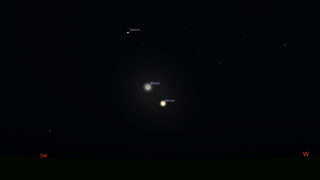
Look to the southwest anytime after dark on Jan. 3, and you'll see a 17%-lit waxing crescent moon very close to Venus. The planet will be about half-lit as seen from Earth, and Saturn will be above the pair.
Saturn occulted by the moon: Jan. 4, 2025 (after sunset)

Saturn will be occulted by a 27%-lit waxing crescent moon for around an hour just after sunset in the southwest, but only for those in Europe. From North America, the two will appear incredibly close.
A crescent moon close to dazzling Venus: Feb. 1, 2025 (after sunset)
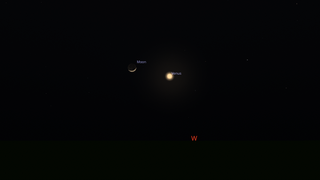
A 15%-lit waxing crescent moon will be close to Venus in the western sky just after sunset. Shining at magnitude -4.8, Venus will dazzle. If you can put a small telescope on Venus, you'll see it as a 37%-lit crescent.
Mars occulted by a full moon: Jan. 13-14, 2025 (after sunset)

Mars will be at opposition, meaning it will be the biggest and brightest it ever appears from Earth. In a celestial coincidence, it will also be blocked by the full moon for over an hour. The exact timing depends on your location, but for Washington, D.C., Mars will disappear behind the moon at 9:16 p.m. EST and reappear at 10:31 p.m. EST on Jan. 13, according to In-The-Sky.org, which gives the times for all locations.
A crescent moon and a crescent Venus: March 2, 2025 (after sunset)

In the third such event of 2025, a glance to the southwest immediately after dark will herald a spectacular view of a very slender, 5%-illuminated waxing crescent moon close to Venus shining at magnitude -4.8. In a small telescope, Venus will be a 13%-lit crescent — a rare and beautiful sight.
A "blood moon": March 13-14, 2025 (night)

It's been a barren time for total lunar eclipses of late, with no such occurrence since 2022. That changes overnight on March 13-14, when the full Worm Moon will rise and, later that night, drift into Earth's dark umbral shadow. The entire "blood moon" event — in which the moon will first lose its brightness and then gradually turn red, then vice versa — will take just over six hours. However, the all-important totality — when 100% of the lunar surface is draped in orange-red light — will last a luxurious 65 minutes.
A stunning "sunrise eclipse": March 29, 2025 (sunrise through midday)

The northeastern U.S., eastern Canada, Europe and northern Russia will witness a partial solar eclipse. Arguably, the best views will be from Maine, New Brunswick and Quebec, which, if skies are clear on the eastern horizon, will witness a big, partially eclipsed sunrise. In the U.K., about 30% to 40% of the sun will be blocked in the late morning.
A crescent moon, Venus and the Pleiades: June. 22, 2025 (before sunrise)
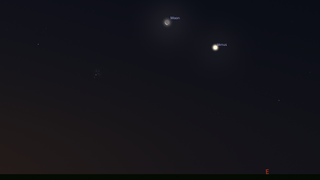
Look east an hour before sunrise, and you'll see a stunning sight: A 13%-lit waning crescent moon will shine just above two beautiful objects: bright Venus on one side and the beautiful Pleiades star cluster on the other.
A crescent moon, Venus and Jupiter: July 22, 2025 (before sunrise)

In the eastern sky before sunrise, a stunning tableau of three celestial objects will appear: Jupiter rising below a delicate, 7%-lit waning crescent moon, with Venus above. The bright-red supergiant star Aldebaran will align with the trio.
A crescent moon close to Venus, Jupiter and Mercury: Aug. 19-21, 2025 (before sunrise)

An hour before sunrise on three successive mornings in August, there will be opportunities to see a beautiful conjunction in the east: Jupiter at the top, Venus below, and Mercury close to the horizon. The moon will pass through this lineup over three days, waning to a slim crescent as it does so.
A crescent moon close to Venus and Regulus: Sept. 19, 2025 (before sunrise)

To see two objects in a very close conjunction is relatively rare. To see three in a perfect close alignment is almost unheard of. Rising in the east shortly before dawn — but still in darkness — will be a 6%-lit waning crescent moon that will appear extremely close to Venus. Regulus, the brightest star in the constellation Leo, will be just beyond the duo. This special sight will have astrophotographers up early.
A second total lunar eclipse: Sept. 7, 2025 (night)

The second total lunar eclipse of the year will be visible only from Australia, Asia, Africa and Europe. Arguably, the best views will be from the Indian subcontinent and Southeast Asia, where the phenomenon will occur high in the sky in the middle of the night, as it did in the March 2025 eclipse in North America. From Europe, the event will take place as the moon rises, making it hard to see. Totality will last 82 minutes.
A second partial solar eclipse: Sept. 21, 2025
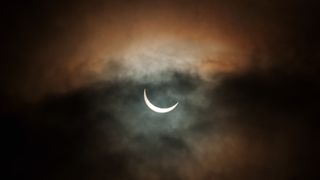
If you want to see the moon's silhouette pass across the sun, get to New Zealand — or on a ship in the Pacific Ocean — to witness as much as 80% of the sun blocked by the moon. Stewart Island, to the south of New Zealand's South Island, will see a 73% eclipse, while Auckland on the North Island will see a 60% eclipse.
The closest supermoon since 2019: Nov. 5, 2025 (after sunset)

There will be three "supermoons" in 2025. As a consequence of the moon's elliptical orbit around Earth, the Beaver Moon will be just 221,818 miles (356,980 kilometers) from Earth, which, according to AstroPixels, will be the closest a full moon has gotten to our planet since 2019. There will be two more supermoons in 2025: the Hunter's Moon, on Oct. 7, and the Cold Moon, on Dec. 4.
A low-hanging Strawberry Moon: Jun. 10, 2025 (after sunset)
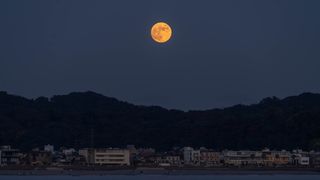
Every 18.6 years, the moon rises to its highest and sinks to its lowest in the sky. This phenomenon, known as a major lunar standstill, will peak in 2025, with the lowest-hanging full moon for 18.6 years occurring on June 10.

.jpg) 14 hours ago
1
14 hours ago
1

 English (US)
English (US)